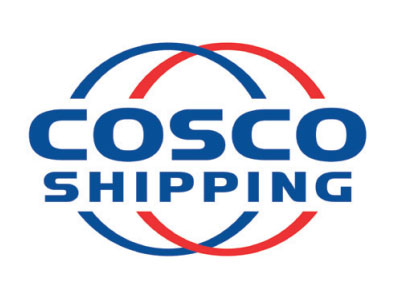COSCO SHIPPING Energy(01138)
Search documents
中远海能完成发行合共6.94亿股A股
Zhi Tong Cai Jing· 2025-10-23 11:04
Core Viewpoint - China COSCO Shipping Energy Transportation Co., Ltd. (中远海能) has announced the completion of all prerequisites for the issuance of A-shares to specific investors, with the issuance set to be completed on October 22, 2025 [1] Group 1 - The company will issue a total of 694 million A-shares at a price of RMB 11.52 per share [1] - The total number of A-shares issued represents approximately 12.71% of the company's total issued share capital after the completion of this issuance [1]
中远海能(01138)完成发行合共6.94亿股A股
智通财经网· 2025-10-23 11:03
Core Viewpoint - China COSCO Shipping Energy Transportation Co., Ltd. (中远海能) has announced the completion of all prerequisites for the issuance of A-shares to specific investors, with the issuance expected to be completed by October 22, 2025 [1] Summary by Sections - The company plans to issue a total of 694 million A-shares at a price of RMB 11.52 per share [1] - The total number of A-shares issued will account for approximately 12.71% of the company's total issued share capital after the completion of this issuance [1]
中远海能(01138) - 中远海运能源运输股份有限公司向特定对象发行A股股票上市公告书

2025-10-23 10:55
香港交易及結算所有限公司及香港聯合交易所有限公司對本公告的內容概不負責,對其準 確性或完整性亦不發表任何聲明,並明確表示概不就因本公告全部或任何部份內容而產生 或因倚賴該等內容而引致的任何損失承擔任何責任。 COSCO SHIPPING ENERGY TRANSPORTATION CO., LTD.* (在中華人民共和國註冊成立之股份有限公司) (股份代號:1138) 海外監管公告 本公告乃根據香港聯合交易所有限公司證券上市規則第13.10B條之規定而作出。 中遠海運能源運輸股份有限公司(「本公司」)之A股在上海證券交易所上市,以下公告為本 公司根據上海證券交易所之要求於上海證券交易所網站刊發之公告。 承董事會命 中遠海運能源運輸股份有限公司 公司秘書 倪藝丹 中華人民共和國,上海 二零二五年十月二十三日 於本公告刊發日期,董事會由執行董事任永強先生及朱邁進先生,非執行董事汪樹青先 生、王威先生及周崇沂女士,以及獨立非執行董事黃偉德先生、李潤生先生、趙勁松先生 及王祖溫先生所組成。 * 僅供識別 中远海运能源运输股份有限公司 向特定对象发行 A 股股票 上市公告书 保荐人(主承销商) 二零二五年十月 1 中远 ...
中远海能(01138) - 国浩律师(上海)事务所关於中国远洋海运集团有限公司认购中远海运能源运输股...

2025-10-23 10:55
香港交易及結算所有限公司及香港聯合交易所有限公司對本公告的內容概不負責,對其準 確性或完整性亦不發表任何聲明,並明確表示概不就因本公告全部或任何部份內容而產生 或因倚賴該等內容而引致的任何損失承擔任何責任。 COSCO SHIPPING ENERGY TRANSPORTATION CO., LTD.* (在中華人民共和國註冊成立之股份有限公司) 海外監管公告 本公告乃根據香港聯合交易所有限公司證券上市規則第13.10B條之規定而作出。 中遠海運能源運輸股份有限公司(「本公司」)之A股在上海證券交易所上市,以下公告為本 公司根據上海證券交易所之要求於上海證券交易所網站刊發之公告。 承董事會命 中遠海運能源運輸股份有限公司 公司秘書 倪藝丹 中華人民共和國,上海 二零二五年十月二十三日 於本公告刊發日期,董事會由執行董事任永強先生及朱邁進先生,非執行董事汪樹青先 生、王威先生及周崇沂女士,以及獨立非執行董事黃偉德先生、李潤生先生、趙勁松先生 及王祖溫先生所組成。 * 僅供識別 国浩律师(上海)事务所 (股份代號:1138) 关于中国远洋海运集团有限公司 认购中远海运能源运输股份有限公司 向特定对象发行 A 股股票 ...
中远海能(01138) - 翌日披露报表

2025-10-23 10:55
FF305 翌日披露報表 (股份發行人 ── 已發行股份或庫存股份變動、股份購回及/或在場内出售庫存股份) 表格類別: 股票 狀態: 新提交 公司名稱: 中遠海運能源運輸股份有限公司 呈交日期: 2025年10月23日 如上市發行人的已發行股份或庫存股份出現變動而須根據《香港聯合交易所有限公司(「香港聯交所」)證券上市規則》(「《主板上市規則》」)第13.25A條 / 《香港聯合交易所有限公司GEM證券 上市規則》(「《GEM上市規則》」)第17.27A條作出披露,必須填妥第一章節 。 | 第一章節 | | | | | | | | --- | --- | --- | --- | --- | --- | --- | | 1. 股份分類 普通股 | 股份類別 A | | 於香港聯交所上市 | 否 | | | | 證券代號 (如上市) 600026 | 說明 A股 | | | | | | | A. 已發行股份或庫存股份變動 | | | | | | | | 事件 | 已發行股份(不包括庫存股份)變動 佔有關事件前的現有已發 | | 庫存股份變動 | 每股發行/出售價 (註4) | | 已發行股份總數 | | | 已發 ...
中远海能(01138) - 国泰海通证券股份有限公司关於中远海运能源运输股份有限公司2025年度向特...

2025-10-23 10:55
(在中華人民共和國註冊成立之股份有限公司) (股份代號:1138) 海外監管公告 香港交易及結算所有限公司及香港聯合交易所有限公司對本公告的內容概不負責,對其準 確性或完整性亦不發表任何聲明,並明確表示概不就因本公告全部或任何部份內容而產生 或因倚賴該等內容而引致的任何損失承擔任何責任。 COSCO SHIPPING ENERGY TRANSPORTATION CO., LTD.* * 僅供識別 国泰海通证券股份有限公司 关于中远海运能源运输股份有限公司 本公告乃根據香港聯合交易所有限公司證券上市規則第13.10B條之規定而作出。 中遠海運能源運輸股份有限公司(「本公司」)之A股在上海證券交易所上市,以下公告為本 公司根據上海證券交易所之要求於上海證券交易所網站刊發之公告。 承董事會命 中遠海運能源運輸股份有限公司 公司秘書 倪藝丹 中華人民共和國,上海 二零二五年十月二十三日 於本公告刊發日期,董事會由執行董事任永強先生及朱邁進先生,非執行董事汪樹青先 生、王威先生及周崇沂女士,以及獨立非執行董事黃偉德先生、李潤生先生、趙勁松先生 及王祖溫先生所組成。 2025 年度向特定对象发行 A 股股票 之 上市保荐 ...
中远海能(01138) - 完成根据特别授权发行A股

2025-10-23 10:54
香港交易及結算所有限公司及香港聯合交易所有限公司對本公告的內容概不負責, 對 其 準 確 性 或 完 整 性 亦 不 發 表 任 何 聲 明,並 明 確 表 示 概 不 就 因 本 公 告 全 部 或 任 何 部 份 內 容 而 產 生 或 因 倚 賴 該 等 內 容 而 引 致 的 任 何 損 失 承 擔 任 何 責 任。 COSCO SHIPPING ENERGY TRANSPORTATION CO., LTD.* 中遠海運能源運輸股份有限公司 (在中華人民共和國註冊成立之股份有限公司) (股份代號:1138) 完成根據特別授權發行A股 茲提述(i)中遠海運能源運輸股份有限公司(「本公司」)日期為二零二五年三月二十五 日的通函(「通 函」),內 容 有 關(其 中 包 括)建議本公司根據特別授權向特定對象發行 A股;及(ii)本 公 司 日 期 為 二 零 二 五 年 一 月 二 十 四 日 的 公 告,內 容 有 關 建 議 向 特 定 對 象發行A股,及 本 公 司 日 期 為 二 零 二 五 年 四 月 十 一 日 的 公 告,內 容 有 關 特 別 股 東 大 會、H股類別股東大會及A股 類 別 ...
中远海能(600026) - 中远海运能源运输股份有限公司向特定对象发行A股股票上市公告书

2025-10-23 10:03
上市公告书 保荐人(主承销商) 中远海运能源运输股份有限公司 向特定对象发行 A 股股票 _______________ _______________ _______________ 二零二五年十月 1 中远海运能源运输股份有限公司 全体董事、高级管理人员声明 本公司全体董事、高级管理人员已对本上市公告书进行了核查,确认不存在 虚假记载、误导性陈述或重大遗漏,并对其真实性、准确性、完整性承担相应的 法律责任。 全体董事签名: _______________ _______________ _______________ 任永强 朱迈进 汪树青 中远海运能源运输股份有限公司 2 李润生 赵劲松 王祖温 年 月 日 王 威 周崇沂 黄伟德 _______________ _______________ _______________ 3 中远海运能源运输股份有限公司 全体董事、高级管理人员声明 本公司全体董事、高级管理人员已对本上市公告书进行了核查,确认不存在 虚假记载、误导性陈述或重大遗漏,并对其真实性、准确性、完整性承担相应的 全体董事会审计委员会签名: _______________ __________ ...
中远海能(600026) - 国泰海通证券股份有限公司关于中远海运能源运输股份有限公司2025年度向特定对象发行A股股票之上市保荐书

2025-10-23 10:02
国泰海通证券股份有限公司 关于中远海运能源运输股份有限公司 (中国(上海)自由贸易试验区商城路 618 号) 二〇二五年十月 中远海运能源运输股份有限公司 上市保荐书 声 明 上海证券交易所: 2025 年度向特定对象发行 A 股股票 之 上市保荐书 保荐人(主承销商) 国泰海通证券股份有限公司(以下简称"国泰海通"、"保荐人"、"本保 荐人")接受中远海运能源运输股份有限公司(以下简称"中远海能"、"发行 人"、"公司")的委托,担任中远海能 2025 年度向特定对象发行 A 股股票(以 下简称"本次发行")的保荐人,本保荐人委派孙逸然和孙兴涛作为具体负责推 荐本项目的保荐代表人。 国泰海通及其保荐代表人根据《中华人民共和国公司法》(以下简称"《公 司法》")、《中华人民共和国证券法》(以下简称"《证券法》")、《证券发行 上市保荐业务管理办法》(以下简称"保荐业务管理办法")、《上市公司证券发 行注册管理办法》(以下简称"《注册管理办法》")等有关法律、法规的规定, 诚实守信,勤勉尽责,严格按照依法制订的业务规则、行业执业规范和道德准则 出具本上市保荐书,并保证所出具文件的真实性、准确性和完整性。 本上市 ...
中远海能(600026) - 国浩律师(上海)事务所关于中国远洋海运集团有限公司认购中远海运能源运输股份有限公司向特定对象发行A股股票免于发出要约事宜之专项核查意见

2025-10-23 10:00
关于中国远洋海运集团有限公司 认购中远海运能源运输股份有限公司 向特定对象发行 A 股股票免于发出要约事宜 之 专项核查意见 上海市山西北路 99 号苏河湾中心 25-28 层 邮编:200085 25-28/F, Suhe Centre, 99 North Shanxi Road, Jing'an District, Shanghai 200085, China 电话/Tel:(+86)(21)52341668 传真/Fax: (+86)(21)52433320 网址/Website: http://www.grandall.com.cn 国浩律师(上海)事务所 二〇二五年十月 | 释 义 2 | | --- | | 第一节 正文 4 | | 一、认购对象的主体资格 4 | | 二、本次发行及认购的批准和授权 5 | | 三、本次认购的基本情况 6 | | 四、本次认购符合《收购管理办法》规定的免于发出要约的情形 7 | | 五、结论意见 8 | | 第二节 签署页 9 | 国浩律师(上海)事务所 专项核查意见 释 义 除非另有说明或依据上下文应另作解释,本专项核查意见中相关词语具有以下 特定含义: | 本 ...